The crusaders and the Venetians built fortresses. From the Arabs came the tasty Meze dish, while Britons introduced driving on the left-hand side. The Turks have had a role in the nationality conflict that led to its division in 1974.
Many rulers have reigned over Cyprus, each leaving their trace.
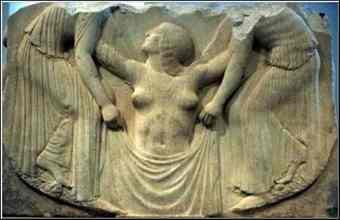 Tourists quickly notice this when they arrive in the place about which Greek novelist Nikos Kazantzakis - author of the world-renowned Zorba the Greek - once remarked, "And even if you went to the end of the world you would find no other island like this one."
Tourists quickly notice this when they arrive in the place about which Greek novelist Nikos Kazantzakis - author of the world-renowned Zorba the Greek - once remarked, "And even if you went to the end of the world you would find no other island like this one."
And just as quickly they agree with the writer, for Cyprus is in fact a small world with a huge amount of variety.
The third-largest island of the Mediterranean is located at the confluence of three continents - Europe, Asia and Africa.
It is appreciated by many visitors above all for its beaches, the seaside and the sunshine.
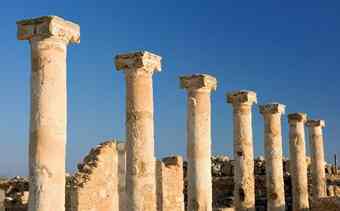 But a treasure which Cyprus can also offer is its wealth of art and cultural treasures. And there is hardly a travel guide that does not start out with a hymn to a divinely beautiful woman, known as Aphrodite in Greek mythology and called Venus by the Romans.
But a treasure which Cyprus can also offer is its wealth of art and cultural treasures. And there is hardly a travel guide that does not start out with a hymn to a divinely beautiful woman, known as Aphrodite in Greek mythology and called Venus by the Romans.
The jagged cliffs that rise from the sea at Petra tou Romiou in south-western Cyprus are unimposing. But it was here that, according to the mythology, the goddess of beauty and love emerged naked from the waves and strolled onto the remote gravel beach.
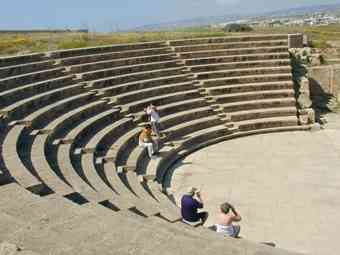 Not far away is Palaia Pafos. In ancient times, this site - near the town of Kouklia - was the centre of the Aphrodite cult. It was here that music and theatre competitions were staged. But not much remains today of that erstwhile cult site, as it was destroyed by an earthquake that only left some foundations and walls standing.
Not far away is Palaia Pafos. In ancient times, this site - near the town of Kouklia - was the centre of the Aphrodite cult. It was here that music and theatre competitions were staged. But not much remains today of that erstwhile cult site, as it was destroyed by an earthquake that only left some foundations and walls standing.
More significant from a cultural-historical standpoint are the ancient mosaics that can be seen at the archaeology park in Paphos. Protected as a UNESCO world cultural heritage site, the park is the city's main attraction.
Paphos has undergone a transformation, from a sleepy fishing village in the 1980s to a major tourism centre today.
In the park, the visitors walk on wooden walkways - the world of the gods lies literally at peoples' feet.
 It is here that Aphrodite makes an appearance too. On one mosaic, Narcissus comes to life. The young man was so much in love with himself that he brushed off the nymph Echo, who then died from the shame of the rejection. As punishment, Aphrodite made Narcissus fall in love with his own image and wither away from self-yearning, to the point that he was transformed into a flower - the narcissus.
It is here that Aphrodite makes an appearance too. On one mosaic, Narcissus comes to life. The young man was so much in love with himself that he brushed off the nymph Echo, who then died from the shame of the rejection. As punishment, Aphrodite made Narcissus fall in love with his own image and wither away from self-yearning, to the point that he was transformed into a flower - the narcissus.
In the bustling port quay of Paphos, meanwhile, fish restaurants and cafes compete for guests. A comfortable seat here is a good place from which to watch the activity in the port.
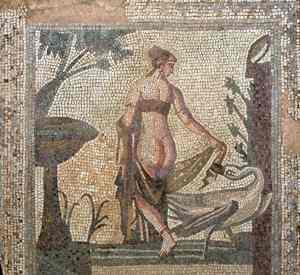 The appearance of Paphos is also marked by the hotels lined up along the coast, featuring more or less fantasy-rich names. Many tourists prefer to bathe in their swimming pools, but naturally they can also swim in the sea or book a scuba-diving course.
The appearance of Paphos is also marked by the hotels lined up along the coast, featuring more or less fantasy-rich names. Many tourists prefer to bathe in their swimming pools, but naturally they can also swim in the sea or book a scuba-diving course.
Most vacationers seem to prefer lying on beach cots, seeking their vacation sunburn. The sun shines very intensively on Cyprus - and for 340 days out of the year.
Paphos is also a good place to visit the fruit and vegetable market, or try out some local specialities in a cafe or tavern at very decent prices.
The "Meze" appetizer can of course be found - tasty titbits on tiny saucers. Almost always, there are olives and skewered baked potatoes, raw and cooked vegetables, and halloumi, the local sheep cheese. The waiter will place a carafe of fruity white wine on your table to go along with it.
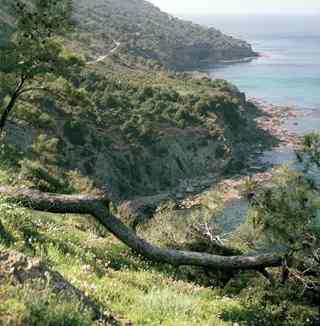 The next day, the tour continues to the Akamas peninsula in the north. Soon, the church Agios Georgios appears, looking down over a small fishing harbour.
The next day, the tour continues to the Akamas peninsula in the north. Soon, the church Agios Georgios appears, looking down over a small fishing harbour.
The asphalt road ends at Cape Drepano, turning into a dirt road. An off-road vehicle is recommended for this stretch - or even better, a mountain bike or hiking boots.
"The Akamas peninsula is under natural protection law and so fortunately has remained free of any hotels," hiking guide Andreas says.
In this area, nearly 600 different plants thrive, including many orchids and wild tulips. In the summer, marine turtles lay their eggs on the beach at Lara, where volunteer helpers keep watch over them.
The most spectacular destination on the hiking trail is the Avgas gorge. In some places, chalkstone columns rise up, with their tops only a few metres apart, providing welcome cooling shade on hot days.
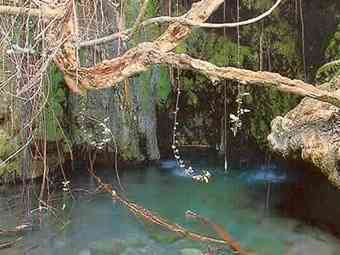 The "baths of Aphrodite" also belong to the Akamas peninsula - though of course there is nothing left over of any peace and quiet.
The "baths of Aphrodite" also belong to the Akamas peninsula - though of course there is nothing left over of any peace and quiet.
Busloads of tourists and young pilgrims arrive at the "fountain of youth," found in a shaded niche in the rocks.
Greek mythology has it that the goddess of love bathed there and fell in love with Adonis - and ever since, the springs guarantee people fortune in love, eternal beauty and many children.
Source: Earthtimes